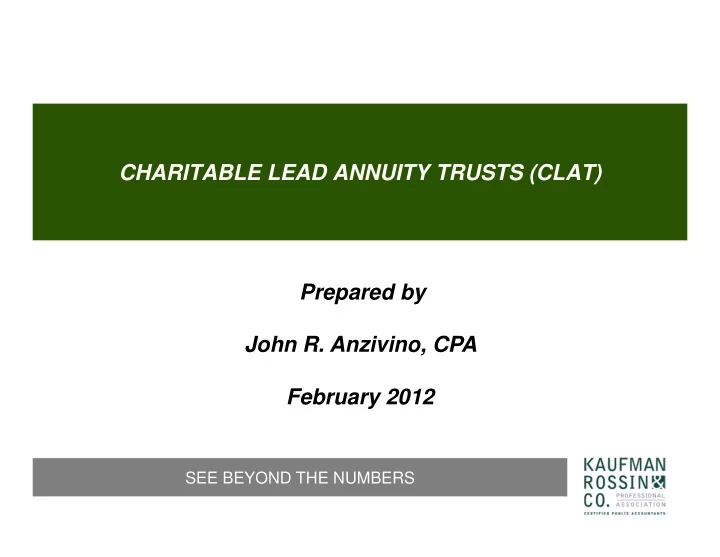

CHARITABLE LEAD ANNUITY TRUSTS (CLAT) Prepared by John R. Anzivino, CPA February 2012 SEE BEYOND THE NUMBERS
Characteristics of a Charitable Lead Annuity Trust Grantor Transfer Assets Annuity Charitable Lead Payments to Charity Charity Annuity Trust Charity receives (the “Lead”) Trust is for term of years payments or for a life, or lives Remainder Remaindermen At end of term remaindermen receive remaining corpus, outright or in trust SEE BEYOND THE NUMBERS
Characteristics of a Charitable Lead Annuity Trust • Grantor transfers property to an irrevocable trust • The charity receives annuity payments based on a fixed annuity • The charity could be a family foundation • The trust pays a fixed amount to charity each year • If the assets transferred to the trust outperform the IRS assumed interest rate (§7520 rate), the excess earnings and growth will pass to the remaindermen at the end of the trust term free of gift and estate taxes • The remainder trust property may pass outright or be held further in trust to postpone the transfer of assets to younger generations SEE BEYOND THE NUMBERS
Zeroed-Out CLAT Gift Tax Consequences Charitable Lead Annuity Trust (20 years) – Transfer Date: Feb 2012 – FMV of Trust: $1,000,000 – Annual Payout: $ 57,680 – PV of Qualifying Interest: $1,000,000 Present Value of Taxable FMV of Property the Qualifying Transferred = Gift Interest (the Lead) $1,000,000 $0 $1,000,000 SEE BEYOND THE NUMBERS
Why are They More Popular? • Interest rates are currently at a record low, creating a greater opportunity to outperform the IRS §7520 rate. Earnings and growth in excess of that rate pass to the remaindermen free of gift and estate transfer taxes With the §7520 rate at only 1.40% (February 2012) fixed • payouts necessary to “zero-out” selected term-certain CLATs are as follows: – 10 year – 10.787% – 15 year – 7.438% – 20 year – 5.768% • Valuation discounts applicable to family limited partnerships and certain other entities can create the opportunity to leverage the benefits of CLATs SEE BEYOND THE NUMBERS
Key Planning Idea Grantor or Non-Grantor Trust Grantor Type Trust • Grantor reports all income/gains during term of trust • Grantor obtains an income tax charitable contribution deduction in the year of creation and not in subsequent years when annuity payments are made to charity • May be beneficial if the grantor’s future income or future income tax rates are expected to decline Non-Grantor Type Trust (Most Often Used) • Grantor does not report any income from the trust • Grantor gets no income tax charitable contribution deduction • Trust will have to pay income tax if trust income is in excess of deductions (including deduction for annuity amount paid to charity ) SEE BEYOND THE NUMBERS
Key Planning Idea Ordering the Tax Attributes To insure that a Non-Grantor type CLAT maximizes the income tax charitable deduction allowed under IRC § 642(c), the trust document should characterize distributions in the following order: • Ordinary income • Capital gain • Unrelated business taxable income • Tax-exempt income • Trust corpus Failure to order the character of payments to the charitable beneficiary will result in all distributions following the tier system set forth by local law, or as pro-rata distributions of all of the items of the trust’s income if local law is silent. SEE BEYOND THE NUMBERS
Key Planning Idea Investing the Assets When managing a non-grantor type CLAT the investment advisor should strive to have the annual “taxable” income (ordinary income and capital gains) equal the annuity payment plus other deductions such as investment management fees and tax preparation fees • If CLAT income exceeds deductions then income tax will be owed If CLAT deductions exceed income then the deductions amount in • excess of income is lost forever SEE BEYOND THE NUMBERS
Key Planning Idea Structure CLAT with Increasing Annual Payouts Treas. Reg. Sec. 25.2702-3(b)(1)(i) and (ii) Qualified Annuity • Irrevocable right to receive a fixed amount • Must be payable . . . at least annually Fixed Amount • Stated dollar amount • Not less frequently than annually • Only to the extent the amount does not exceed 120 percent of the stated dollar amount payable in the preceding year SEE BEYOND THE NUMBERS
$1,000,000 Funding Contribution Zeroed-out CLAT – 20 Years SEE BEYOND THE NUMBERS
Recommend
More recommend